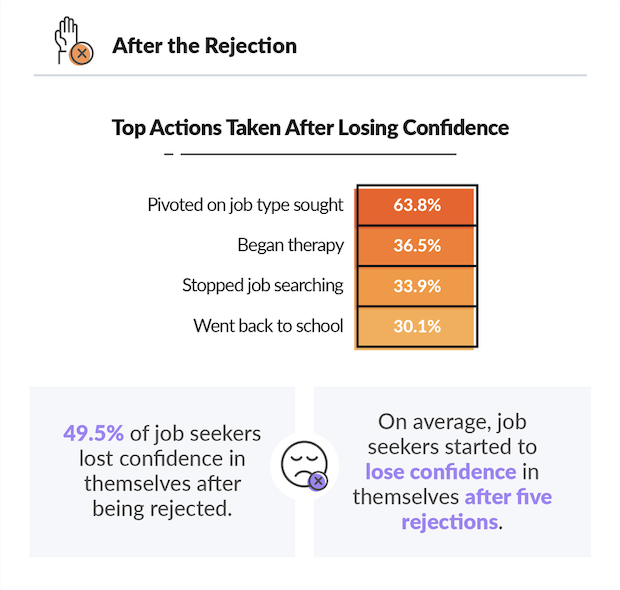How do you turn rejection into something positive?
You find a lot of content centered around writing the perfect resume, how to use job listings to your advantage, or how to ace interviews. However, many forget about what comes after. We all want to be optimistic and think that we’ll get the job we applied for, but the reality is that you’ll likely take a few knocks before finding “the one.”
This means that you’ll inevitably face rejection. While it’s not the nicest thing to think about, rejection can actually be a positive. That’s because knowing how to handle rejection can lead to unexpected benefits.
If you’ve ever stared at a rejection email in a mixture of disappointment and disbelief and at a loss for how to reply, then this article is for you. We’ll be talking about how best to respond to job rejection emails, all while giving you tips and tricks to make the best of the situation, with examples
What is a job rejection email?
At its core, a rejection email is a message sent by the company you applied to that lets you know that your application was unsuccessful.
Beyond this, the contents of the email can vary. Some companies will leave it at that, while others will offer constructive feedback or even tell you about other positions they have open.
The feedback can also vary; certain organizations will give broad feedback, and others may give more actionable points, such as pointing you in the direction of a course that you can take to strengthen your application in the future.
Dealing with rejection
Though most of us have had to face the difficulty of rejection, it’s easy to fall into a pit of despair after being told “no.” This is especially true when it’s one after the other. A recent study by Joblist found that 49.5% of job seekers lost confidence in themselves after being rejected.
There are a few things to remember to keep you from becoming depressed when the rejection emails come in.
There is more out there
While the job you applied for may have sounded like a dream, always remember that there is more out there. Though it may take a bit of time to find another job listing that fits your requirements, use it to hone your resume, craft a more thorough cover letter, or perhaps convert the constructive criticism received from the company into actionable points.
For instance, the hiring manager might suggest you take a course that teaches you how to best handle a conversational artificial intelligence platform to better your chances for the next senior customer service position you apply for. Take the advice and use it to develop your skill set.
Whatever it is that you do, keep reminding yourself that there are new job listings every day, and one of your applications will be successful, even if it takes longer than anticipated.
“No” now doesn’t mean “no” forever
As we’ll see later in this article, just because a company has turned you down for a particular post, it doesn’t necessarily mean that you aren’t a good fit for them.
You may be able to further enquire about another post, or, following a particularly successful interview, they may even propose another role that they feel would suit your skillset more.
There’s a reason why, on the other side of the coin, hiring managers are busy looking for templates for the perfect rejection letter—they know that a previously rejected candidate could be the perfect fit for a future role. So don’t get disheartened!
Seize the learning opportunity
As we’ve mentioned, companies do provide constructive criticism. Take the time to understand it and put it into practice.
Also, take the process as a teaching moment. Those interviews that may not have gone well? See them as practice runs. Think back to what worked, what didn’t, and which questions left you stumped, and research to find out exactly how to build upon your strengths, avoid those pitfalls, and answer unexpected questions.
Have a plan
Having a strategy in place for rejection emails may seem overly dramatic or perhaps too cautious, but it does help in various ways.
Having a plan gives you something to do other than dwell on the rejection. What’s more, putting it into action won’t be just a distraction but a way forward and will help you to use your time constructively.
Depending on how effective your plan is, it can ensure that you are maximizing your situation. As we’ll soon see, there is a lot to be potentially gained from a correct response to a rejection email. A plan that includes the right responses can land you a winning application!
Why your response matters
Although it may be disheartening in the moment, responding the right way to a rejection email can have many advantages.
Networking
Depending on the response you give, you can portray yourself as a mature, available, and forward-thinking individual who is always looking to improve. It also shows that you have intrapersonal skills. Those are very valuable characteristics that employers look for.
In the end, the person the hiring manager ended up selecting might not take the role, and the company may turn to previous candidates from the hiring pool. Having shown your skills, even if via email, could put you above the rest.
Responding also allows you to keep a line of communication open. Employers will feel more comfortable about reaching out to you with possible opportunities if you’ve left the door open, so to speak. These opportunities may come in the form of positions at the same company or recommendations for other listings.
Valuable insights
While some provide feedback instantly, other organizations need to be asked. This feedback is important, and you should seek it whenever possible. What better source to obtain insight from than potential employers?
Tips for responding to a job rejection email (with examples)
Now that we’ve covered what a job rejection email is and why you should make time to respond to one, let’s get into the how.
Below are seven tips that you can use to craft a good response and make the most out of the situation. You’ll also find examples that illustrate each piece of advice.
1. Have a strong subject line
The first thing that the hiring manager, or whoever is in charge of hiring applications, will see is the subject line of your email. It must be straight to the point and informative to increase the likelihood of your email being opened and read. An ill-suited subject line is actually one of the reasons behind an email marketing failure; that’s how important it is to get it right.
Example:
Example 1: Response to job application at [company] for [role].
Example 2: Open for other opportunities at [company].
2. Be polite
It never hurts to be polite. In this case, it helps to keep a communication line open and encourages a fruitful exchange. A hiring manager is less likely to help you if you are rude, inconsiderate, or even aggressive.
To this end, make sure to thank them for their time and, if they provided feedback, for that also. Don’t forget to close off the email professionally, too!
Example
I would like to thank you for taking the time to consider my application and getting back to me. I also greatly appreciate your feedback; I’m always looking to improve, and this will be very helpful.
3. Be positive
Setting the correct tone for your correspondence is important for any email communication. To develop a potentially fruitful relationship between yourself and the company, focus on the positive. So, avoid talking about what you felt went wrong or why you believe they’ve made a mistake not hiring you.
Instead, convey your appreciation for the overall experience and your dedication to bettering yourself and your application. If you’ve been interviewed and found the interviewer(s) to be particularly nice, you can also make this known. If you’re interested in their approach to using AI in a call center environment, tell them here.
Example
Interviewing with your company for [position] was a very positive experience. [Interviewee] was a pleasure to talk to and did a great job of putting me at ease.
4. Show enthusiasm and interest
Just because you didn’t secure the role, it doesn’t mean that the interest and enthusiasm you previously showed have disappeared.
If anything, showing interest and enthusiasm even after a rejection shows your resilience, and it lets the company know that you are serious about wanting to work with them. It also encourages the hiring manager to get back to you should any positions open up.
If they’ve given you feedback in their initial email, you can even tell them that you’ve already begun acting on it. For instance, they may have explained that your knowledge gap on AI in the workplace examples was the reason you weren’t selected. In this case, work towards filling that gap and let them know this in your response.
Example
Your company values resonated with me, and I would be greatly interested in working with you and being part of your team in the future. I appreciate your feedback and have already signed up for a course on remote support. Thank you for providing me with actionable feedback.
5. Ask for feedback
As we previously pointed out, some companies will provide feedback unprompted, and others need to be asked.
Asking for constructive comments is a great way to show your dedication to self-improvement.
Keep in mind that although you may ask, a company might not provide any feedback. Don’t take it personally—some companies have too many applicants and not enough time to reply to each with specific constructive criticism.
Example
Could you please let me know of any areas in which I could improve? I’m very keen on continuously working on my professional development and would love to hear from you.
6. Ask to be updated on future opportunities
Having set the right tone, thanked them for their time, and taken their feedback on board, it’s now time to ask about future roles that may open up at the company.
They may get back to you about roles for which they are actively recruiting or tell you that they’ll let you know if anything pops up. Either way, you lose nothing by asking. Consider letting them know what sort of role you’re interested in besides the one you applied for with them, whether that’s in customer experience management or developing the best call center software for small business.
Example
Would you kindly let me know if there are any open positions at [company] that you feel may be a good fit for me? I would love to be a part of your company and would greatly appreciate the opportunity to interview for another role.
7. Leave a way for them to contact you
Although they’ll have an email address through which to reach you, leaving a more accessible mode of contact is a good idea.
That way, if an opportunity does come about, they can contact you quickly. The same goes for recommendations, as they can pass on your mobile number, for example, to other employers looking for new hires.
Example
Please don’t hesitate to contact me should any further opportunities open up. You can email me at this address or, if you prefer, you can reach me at [phone number].
Turn job rejection email into an opportunity
No one enjoys rejection. However, you can turn what seems to be a negative into a positive if you approach the situation with the right mindset and a well-thought-out plan.
Don’t shy away from responding to job rejection emails with confidence and enthusiasm using the seven tips outlined above. Not only will this help you deal with the initial disappointment that comes with a rejection, but it will also increase the opportunities available to you. Remember, though, keep it simple and to the point.
Best of luck!









